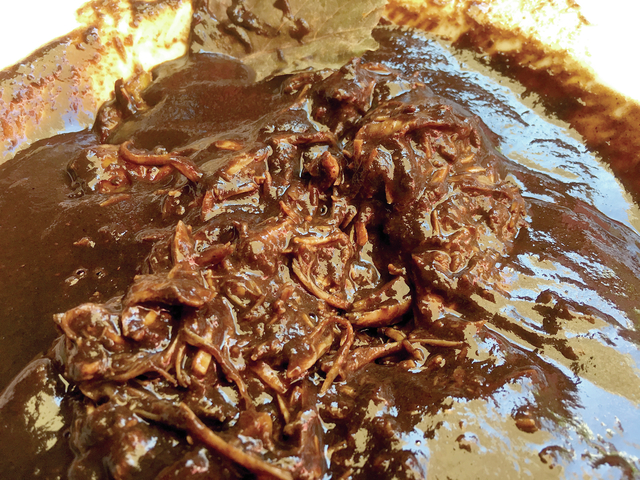Let’s Talk Food: Chocolate for lovers
When we think of Valentine’s Day, we immediately think of chocolate. I am here in the city of Oaxaca, Mexico, where chocolate is an important beverage in daily life. Mexico also is the birthplace of cacao consumption.
ADVERTISING
If you check out the history of chocolate, you will see why it is so popular in Mexico as it is traced back to 1,900 BC, with the Aztecs who believed the cacao seeds were a gift of Quetzacoatl, the god of wisdom. Cacao seeds were used as a form of currency as it was considered so precious. Originally, a chocolate drink was made with spices, wine and corn puree.
The ancient Aztecs believed drinking chocolate drinks had aphrodisiac powers and gave the drinker strength. The original name for this drink was “chicolati,” which meant “beaten drink.”
Chocolate drinks are so much a way of the daily life of the people of Oaxaca. Common in Oaxaca is a combination of chocolate, sugar, cinnamon and almonds, typically mixed with water, unlike in America, where warm milk would be mixed with chocolate to make hot chocolate. As we walked around the streets of Oaxaca, it was easy to find a street vendor selling the traditional chocolate de agua. Using a “molinollo,” or wooden mixer that is held in both palms of your hands and swirled to create a thick layer of head foam, the vendor then poured us a steaming cup. This chocolate drink is typically eaten with “pan de yema,” or egg bread, which is perfect for dunking, for breakfast or as a midday snack.
You would think such an important food that is so much a part of their daily consumption would also be grown in Mexico, but most of their chocolate comes from Central America and Africa.
We walked in Oaxaca’s chocolate district along Francisco Javier Mina Street, which started with the flagship Mayordomo chocolate shop founded in 1956. As we walked along this bustling street, we encountered the flagship La Soledad, which is more than 70 years old, with a retail shop and even the Chocolate Hotel. We decided to stop to have a chocolate drink and taste it with egg bread. La Soledad had a large selection of chocolate flavors as well as other products, including a large assortment of moles and mezcal. They also make a “chocomiel,” which is chocolate and honey.
The street was bustling with activity and there were even more Mayordomo shops, similar to walking in Waikiki and seeing an ABC Store on every corner. We watched as a huge truck unloaded buckets and cases of Mayordomo products to its stores along the streets. It certainly had a smell of chocolate in the air.
All chocolate producers in town make different types of table chocolates and mole sauces. Their table chocolate contains roasted cacao beans, sugar, almonds and ground cinnamon in various ratios. In addition, customers often bring their own sourced cocoa beans and spices and have their chocolate milled for them to their liking and family recipe. If this mixture is tasted as is, you will find it to have a rough mouth-feel as there is undissolved granulated sugar. When I bit into the chocolate in Oaxaca, I was surprised about how grainy the texture was, unlike the chocolate to which we are accustomed. I was told by my cooking teacher that the chocolate is not tempered but instead just formed into blocks to be used to make the chocolate drink.
In Oaxaca, chocolate also is an important ingredient in making “mole negro,” or black mole. My cooking school’s recipe for mole negro has 26 ingredients and probably will never be made, so I found a less complicated recipe from Saveur that I have made before and for which I was able to get the ingredients locally or online.
Chicken mole
Serves: 8
In a heavy, large Dutch oven over medium-high heat, add:
3 tablespoons vegetable oil
Season with salt and pepper:
5 pounds boneless, skinless chicken thighs
Working in batches (do not overcrowd), place chicken in heated Dutch oven and lightly brown on all sides. Remove to a large platter or bowl and continue cooking all chicken, adding more oil if needed. Return chicken and any juices to pot, add:
3 cups chicken broth
2 cups orange juice
Bring to a boil, then reduce heat to medium-low, covered, and cook until chicken is cooked through, about 25 minutes.
Meanwhile, heat in a large saucepan:
2 tablespoons vegetable oil
3 large onions, sliced
Saute until golden brown, about 20 minutes. Reduce to medium, add:
1/2 cup sliced almonds
6 large garlic cloves, sliced
4 teaspoons cumin seeds
4 teaspoons coriander seeds
Saute until almonds and garlic begin to turn light brown. Add:
4 ounces dried pasilla chiles, stemmed, seeded, torn into 1-inch pieces
1 ounce dried negro chiles, stemmed, seeded, torn into 1-inch pieces
Stir and cook until chiles start to soften. Add and simmer until chiles are very soft, about 30 minutes:
1/4 cup raisins
4 strips of orange peel (no white piths)
1 1/2 teaspoons dried oregano
Remove from heat, add:
3 ounces Mexican chocolate, chopped
Let stand until chocolate melts, about 15 minutes.
Place sauce mixture into blender and blend until smooth. Return to pot, season with salt and pepper.
Coarsely shred chicken and place into sauce, stir to coat. Transfer chicken mole to bowl, sprinkle with chopped cilantro and serve with warm corn or flour tortilla.
Foodie bites
Don’t forget to call the Hawaii Community College Culinary Program to check out the Bamboo Hale and the Cafeteria. I am sure they will have a special lunch today for Valentine’s Day. Sorry I missed the foods of Mexico last week.
Happy Valentine’s Day to all my readers.
Email Audrey Wilson at audreywilson808 @gmail.com.





